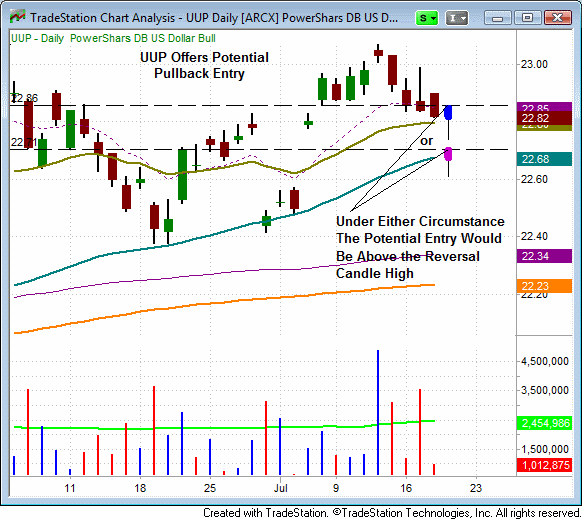In our evaluation of potential swing trade setups when doing our nightly stock scanning, we attempt to visualize potential trading scenarios that could provide logical entry points in ETFs or stocks we are monitoring for potential entry.
The daily chart of PowerShares DB US Dollar Bull ETF ($UUP) below provides an excellent example of using this process:

Since forming a “swing high” resistance level on July 12th (see chart above), $UUP has been selling off for the past four sessions, and is now closing in on near-term support of its 20-day exponential moving average (EMA). However, just because an ETF or stock retraces to touch or nearly touch a support level, it does not mean that the technical setup automatically offers a buying opportunity.
Traders often make the mistake of entering a trade just because a key support level is “touched” by an ETF. Many newer traders act as if there is a magical force in the trading universe that will bring the ETF to a halt at that precise level. But in reality, there is no way to know where the ETF or stock will ultimately find support before reversing to resume its dominant trend.
Although it is likely that $UUP will find some type of support at its 20-day EMA (the beige line on the chart), there is no way to know how significant this support will be.
For instance, $UUP might just hesitate at the 20-day EMA for a day or two and then move lower. In other words, it may not find significant support at this moving average. It could continue to drop and ultimately find more significant support at its 50-day moving average (MA).
So how do we know when an ETF or stock has likely found price support at a key moving average? We wait for it to provide proof that it may be ready to reverse.
This proof often comes in the form of a “reversal candle.” For pullback entries, we look for significant reversal candles to form near key support levels (see hypothetical blue and pink candlestick bars on chart).
A significant reversal candle would be defined as the ETF or stock trading at least one ATR (Average Trading Range, or average difference between intraday low to high) and the price action “undercuts” the moving average, but the price reverses to close near its intraday high (generally in the upper third of the day’s range). This signals that momentum may be shifting from the bears to bulls.
This is particularly true when the reversal candle forms on high volume and is long (the longer the “wick” of the candlestick, the better). The chart pattern of $UUP above illustrates the type of “reversal candle” we would like to see in order to provide a low-risk swing trading entry point into UUP:
After an ETF or stock has formed a “reversal candle,”as indicated above, the exact entry point becomes clear. We simply look to buy on a rally above the high of the reversal candle (the prior day’s high). A protective stop order can then be placed below that day’s intraday low.
In the event the reversal candle never forms on the pullback, there are alternative entry points that can be applied, which we teach to regular subscribers of our nightly ETF and stock newsletter.
Since $UUP has been in a primary uptrend for approximately nine months, and our trading strategy is based on following the direction of the dominant market trend, we would only look to potentially enter $UUP only on the long side. With this in mind, $UUP could soon offer a buying opportunity on a pullback.
Candlestick chart patterns such as above are just one part of our overall stock trading strategy, but any element of technical analysis that slightly increases one’s odds of consistent stock market profitability is worthy of implementation.
If you are new to short-term ETF or stock trading and are looking for a trading system that works, you will find a plethora of valuable articles, insights, and technical analysis right here on our trading blog.

Great article!
Hi Mark,
Thanks for your feedback and glad you enjoyed the article. We will keep the educational trading articles coming.
Cheers,
Deron